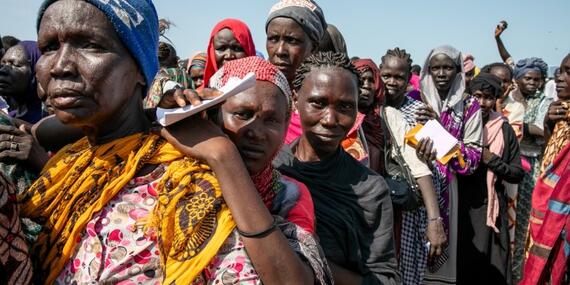Today's top news: Famine risk, Occupied Palestinian Territory, South Sudan

Famine risk
Ahead of the Group of Seven (G7) summit starting tomorrow, the Under-Secretary-General for Humanitarian Affairs, Martin Griffiths, is appealing to G7 leaders to use their influence to prevent manmade famine.
In a statement issued earlier today, he warned that conflict is fueling hunger in too many corners of the world – from Mali to Myanmar. But, he said, nowhere is the choice between inaction and oblivion so clear as in Gaza and Sudan.
In Gaza, half of the population – more than a million people – is expected to face death and starvation by the middle of July. In Sudan, at least 5 million people are also teetering on the brink of starvation, including in war-torn parts of Aj Jazirah, Darfur, Khartoum and Kordofan.
Griffiths said waiting for an official declaration of famine before acting would be a death sentence for hundreds of thousands of people and a moral outrage. He called on G7 countries to bring their substantial political leverage and financial resources to bear so that aid organizations can reach all people in need.
Occupied Palestinian Territory
UNICEF warns that nearly 3,000 children in southern Gaza have been cut off from treatment for moderate and severe acute malnutrition – putting them at risk of death. The agency is also concerned that malnutrition cases could continue to rise, at a time when treatment services are collapsing.
Only two of three stabilization centres that treat seriously malnourished children in Gaza are still functioning. UNICEF says plans for the opening of new centres have been delayed due to ongoing military operations across the Strip.
According to OCHA’s latest update on the humanitarian response, escalating hostilities across Gaza continue to pose significant barriers to accessing healthcare. Despite these challenges, humanitarian partners are currently reaching some 280,000 people per week in Gaza with health services.
Meanwhile, a shortage of cooking gas and the absence of a public power supply is hindering efforts to keep community kitchens and bakeries running. Efforts to distribute food remain constrained by the active fighting, damaged roads, limited number of entry points into Gaza, sub-optimal operating hours at crossings and checkpoints and the limited number of trucks allowed access. To roll back months of near-starvation conditions in Gaza, other types of critical aid must also reach people in need.
OCHA warns that the situation in the West Bank, including East Jerusalem, continues to escalate, amid ongoing violence by Israeli forces and settlers. Since 7 October, more than 520 Palestinians – nearly a quarter of them children – have been killed in the West Bank, including East Jerusalem. Almost three quarters of those fatalities occurred during operations by Israeli forces. During the same period, more than 5,200 Palestinians were injured in these areas.
OCHA says violence against Palestinians by Israeli settlers is also on the rise, with more than 960 such attacks reported in the West Bank, including East Jerusalem.
South Sudan
In South Sudan, the humanitarian community is working to support the most urgent needs of hundreds of thousands of people, including those fleeing the conflict in neighbouring Sudan and host communities.
Yesterday, the Humanitarian Coordinator in South Sudan, Anita Kiki Gbeho, released US$20 million from the South Sudan Humanitarian Fund to provide life-saving assistance to some 290,000 of the most vulnerable people in four locations near the border with Sudan. Some 700,000 people have crossed into South Sudan since April 2023, when conflict erupted in Sudan.
This is the first allocation of the year and comes at a critical time to prevent the hunger situation in South Sudan from worsening, with the current lean season expected to increase levels of food insecurity and malnutrition.
Gbeho said despite generous contributions from donors, additional funding is needed. Five months into the year, the 2024 Humanitarian Response Plan for South Sudan is less than 20 per cent funded, with $327 received of the $1.8 billion required.
